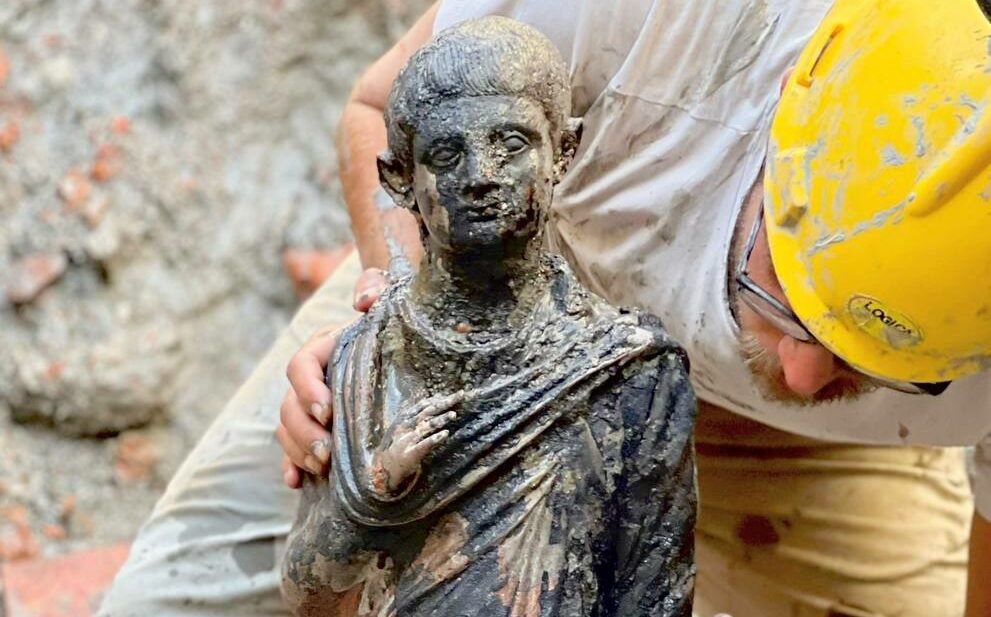Tuscany continues to amaze us. The region, admired all over the world, visited by millions of tourists every year and a bona fide “artistic magnet” for centuries, acquired a new jewel for its crown.
In the Siena province, in the very same hills we know for Montepulciano and Montalcino wines, and for the gentle, undulating roads leading to the lakes Trasimeno and Bolsena, there is a small village of just 1,500. It is listed among the Borghi più Belli d’Italia and received a touristic-environmental award from the Touring Club Italiano thanks to its thermal baths.
San Casciano dei Bagni lives off all this, and it’s famous for the wellness it gifts to those dipping into its naturally warm waters. A natural paradise, known since time immemorable. This is the reason why archaeologists considered the area interesting and wanted to investigate it further.
And so, little by little, just a stone’s throw from the thermal baths, digs brought to light a temple dedicated to Apollo first, and then twenty-four bronze statues in impeccable condition, perfectly preserved by warm thermal muds. In the not-distant future, the area will become an archaeological park, and soon, the statues – which have been unearthed by a team of international experts – will become a must-see, a new tourist attraction for all those visiting Tuscany.
It’s not a case locals candidly declared to the Guardian that those thermal muds are like “petrolio,” oil: they are tomorrow’s wealth.
“This discovery doesn’t only offer San Casciano new touristic and cultural opportunities, but could become the beginning of a true renaissance,” Agnese Carletti, the village’s mayor, declared. Carletti officially stated that “San Casciano will have a new museum, which will become the home of these exceptional statues, and an archaeological park. Two new sources of development, along with the galvanizing presence of so many young archaeologists from all over the world who, thanks to this dig, bring a new lease of life to the village for several months every year.” It is hoped the discovery will benefit tourism, which is a lifeline of the Tuscan economy but has suffered a lot in recent years both because of the pandemic and, more recently, because of the rise in energy costs due to the conflict in Ukraine. But also that it will help fight depopulation in the area.
In other words, the discovery makes us understand what Italy’s “petrolio,” the country’s raw material that has been generating growth and development for years, really is: arts and culture. They are not the past, but something to preserve and protect today so that they can become a resource for the future.
Gabriele Nannetti, the superintendent for archaeology, fine arts and landscape for the Siena, Grosseto and Arezzo provinces said that “The discoveries of the Great Bath represent an extraordinary excellence in a context, that of our archaeological patrimony, already incredibly rich, and that the Superintendence must protect. All this confirms once more how
archaeology can surprise us at any given time with new, incredible discoveries and research possibilities.”
Material wealth, of course, jobs, tourism, a boost to the local economy, but also cultural wealth, a material and also intangible patrimony that placed Italy at the top of the famous UNESCO list.
“This exceptional discovery confirms once more that Italy is a land of immense, unique hidden treasures. The stratification of civilizations is a specific characteristic of Italian culture,” Italy’s minister for culture Gennaro Sangiuliano said while visiting the Istituto Centrale del Restauro, where early intervention on the San Casciano statues is undergoing. “Studying and valorizing this treasure enhances the spiritual growth of our culture and could represent a key moment for the rediscovery of areas little known to international tourism. It is also, of course, a boost for the nation’s cultural industry.” We only need to believe and invest in it but not only economically: also with creativity and spirit of divulgation.
La Toscana continua a sorprendere. Già ammirata dal mondo, visitata da milioni di turisti all’anno, calamita culturale, artistica e architettonica da secoli, oggi ha un gioiello in più.
Nel Senese, tra le tranquille colline che tanti conoscono per i vini di Montepulciano e Montalcino e le strade ondulate che portano ai laghi Trasimeno e Bolsena, c’è un comune di appena 1500 abitanti che fa parte del circuito dei borghi più belli d’Italia e si fregia del marchio di qualità turistico-ambientale conferito dal Touring Club Italiano grazie alle sue terme.
San Casciano dei Bagni vive di questo, è famosa per il benessere che regala a chi si immerge nelle sue acque calde che sgorgano in mezzo alla natura. Un paradiso naturale noto da sempre. E proprio questo deve aver fatto capire agli archeologi che quella era un’ottima ragione per indagare.
Così poco alla volta, proprio a due passi dalle terme è riemerso prima un tempio dedicato ad Apollo e poi 24 statue in bronzo che sembrano appena fatte, conservate meravigliosamente dai fanghi caldi.
In futuro sorgerà un parco archeologico e presto queste meravigliose statue, appena recuperate da un team di esperti internazionali, diventeranno una nuova tappa turistica, una meta obbligatoria per chi visiterà la Toscana.
Non è un caso che gli abitanti della zona a The Guardian abbiano sinceramente detto che quei fanghi termali in realtà sono “petrolio”: la ricchezza di domani.
“Questa scoperta offre a San Casciano un’opportunità che non è solo culturale e turistica, ma è una vera e propria occasione di rinascita”. Il sindaco del borgo toscano, Agnese Carletti, lo ha detto ufficialmente: “A San Casciano nasceranno un nuovo museo, che ospiterà le eccezionali statue, e un parco archeologico. Due nuovi luoghi che saranno per il territorio un vero e proprio motore di sviluppo che andrà ad aggiungersi alla già entusiasmante presenza dei giovani archeologi provenienti da tutto il mondo che, grazie a questo scavo, stanno ripopolando il paese ormai per molti mesi all’anno”. Il ritrovamento si spera possa dare una spinta non solo al turismo, motore collaudato in Toscana ma che deve comunque risollevarsi dopo le ferite lasciate dalla pandemia e i pesanti contraccolpi sui costi energetici legati al conflitto in Ucraina, ma serva anche a combattere lo spopolamento e l’emigrazione dei giovani.
La scoperta fa cioè capire qual è il vero petrolio italiano, l’abbondantissima materia prima dell’Italia che non smette di generare crescita e sviluppo: l’arte e la cultura che da millenni la riempiono di bellezza. Non sono il passato ma un presente da preservare perché sia la ricchezza del futuro.
“Le scoperte di Bagno Grande costituiscono un’eccellenza straordinaria nel pur ricchissimo patrimonio archeologico sul quale la Soprintendenza è chiamata a esercitare le funzioni di tutela, confermando ancora una volta che il settore dell’archeologia può sorprenderci in ogni momento con nuove e straordinarie scoperte e possibilità di ricerca”, ha detto il Soprintendente Archeologia, Belle Arti e Paesaggio per le province di Siena, Grosseto e Arezzo, Gabriele Nannetti.
Ricchezza materiale certo, posti di lavoro, economia locale, turismo, ma ovviamente anche ricchezza culturale, patrimonio materiale e immateriale dell’umanità per cui l’Italia spicca in testa alla lista dell’Unesco.
“Un ritrovamento eccezionale, che conferma una volta di più che l’Italia è un Paese di tesori immensi e unici. La stratificazione di diverse civiltà è un unicum della cultura italiana” ha detto il ministro della Cultura Gennaro Sangiuliano visitando il laboratorio dell’Istituto Centrale del Restauro, dove sono in corso le attività di studio e i primi interventi sui bronzi: “Lo studio e la valorizzazione di questo tesoro sarà un’ulteriore occasione per la crescita spirituale della nostra cultura e per il rilancio di territori meno noti al turismo internazionale, ma anche come volano per l’industria culturale della nazione”. Basta crederci e investire non solo risorse economiche ma soprattutto energie creative e divulgative.






























